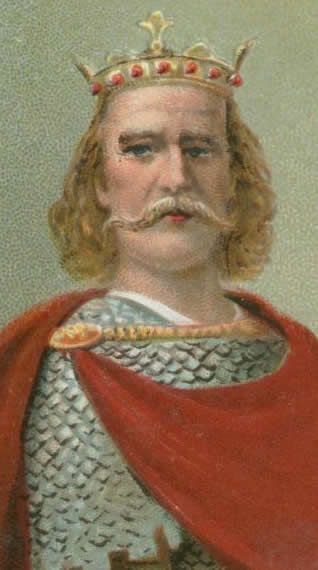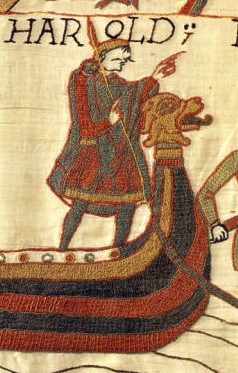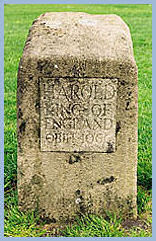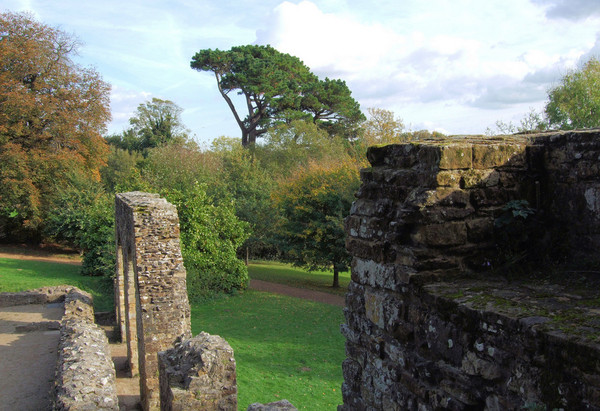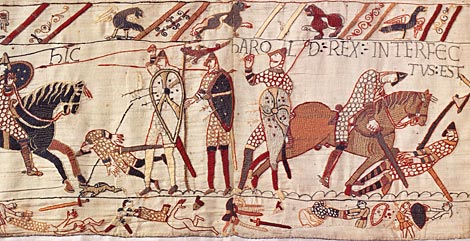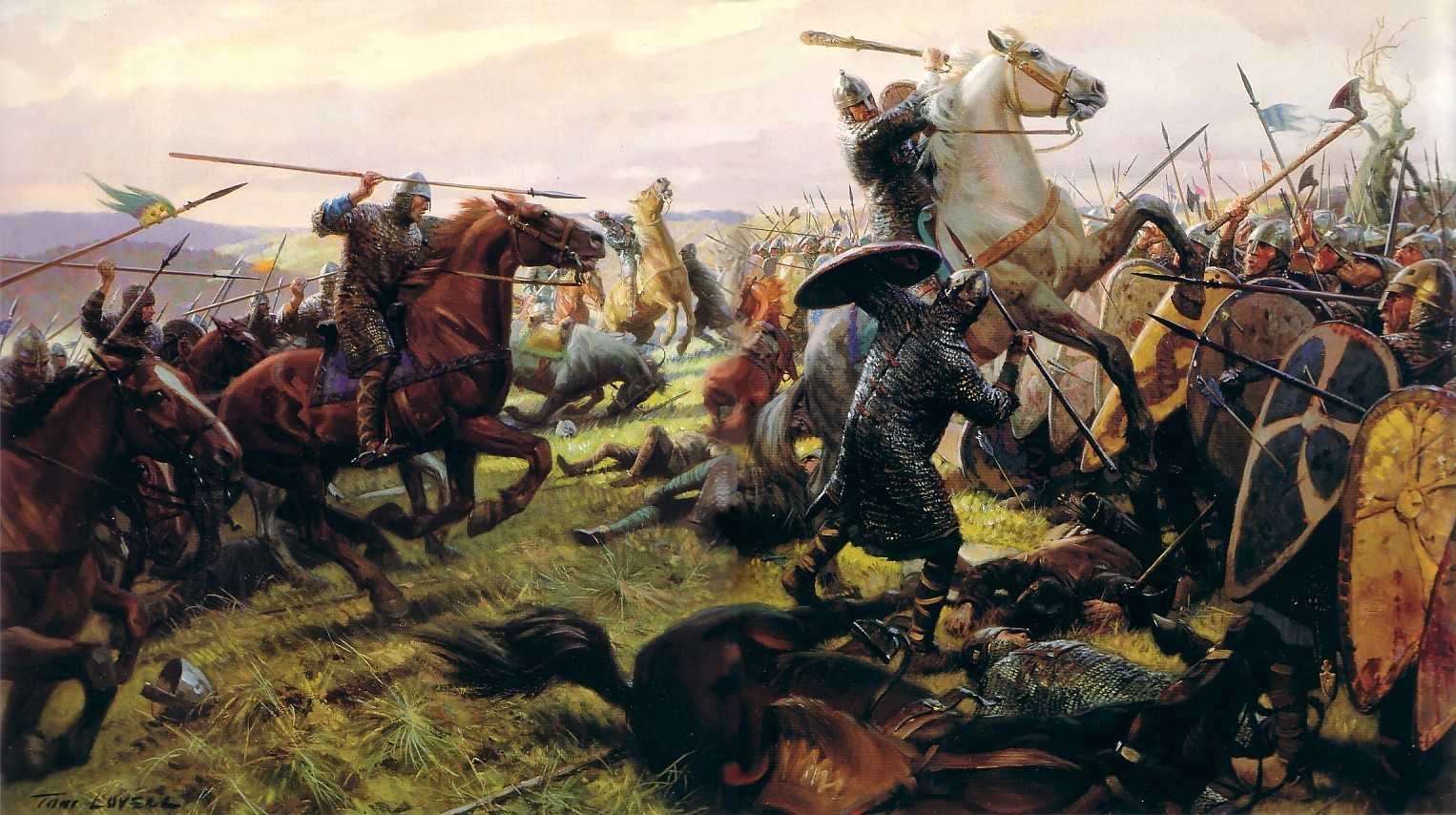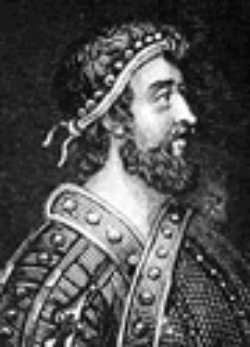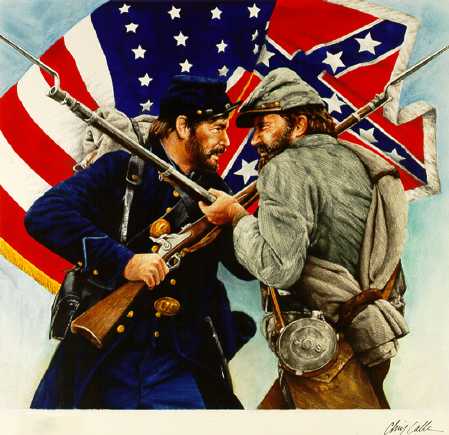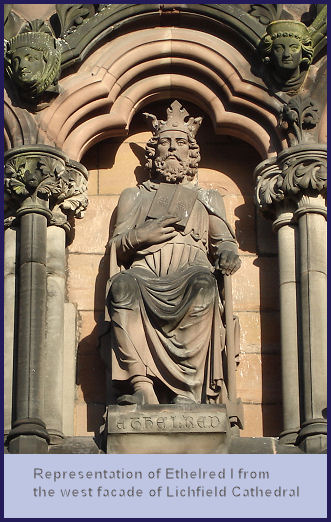Name: King Harold II
Born: c.1020
Parents: Godwin, Earl of Wessex, and Gytha of Denmark
Relation to Elizabeth II: husband of the 30th great-grandmother
House of: Wessex
Ascended to the throne: January 5, 1066
Crowned: January 6, 1066 at Westminster Abbey, aged c.43
Married: (1) Eadgyth (Swan-neck), Daughter of Earl of Mercia (2) Ealdyth widow of Gruffydd ap Llywelyn
Children: 1 or 2 sons and several illegitimate children
Died: October 14, 1066 at Senlac Abbey, Sussex, of wounds following the Battle of Hastings
Buried at: Pevensey reburied Waltham Abbey
Reigned for: 9 months, and 8 days
Succeeded by: Edgar the Aethling, and then Edward the Confessor’s 2nd cousin William of Normandy
Last Anglo-Saxon king of England, January to October 1066. He was defeated and killed by William of Normandy (William the Conqueror) at the Battle of Hastings.
Harold succeeded his father Earl Godwine in 1053 as Earl of Wessex.. He had no bloodline to the throne but his sister Edith was married to King Edward the Confessor. In January 1066 when Edward died childless, the Witan (or Witenagemot a council of high-ranking religious and secular men) elected Harold to succeed him and one day later he was crowned King Harold II. William of Normandy claimed that he had been promised the throne by his relative Edward and that in 1063 Harold had sworn allegiance to support his claim. On hearing of Harold’s coronation William prepared to invade England to claim the throne.
Meanwhile, Harold’s brother Tostig who had quarrelled with Harold joined the king of Norway Harald Hardrada in invading Northumbria. Harold routed and killed them at Stamford Bridge, near York, on 25 September. Three days later William landed at Pevensey, Sussex, and Harold and his army marched quickly South to face him. The Battle of Hastings took place on 14 October 1066. Harold’s army was defeated and he was killed in the battle.
The Witan elected 15 year-old Edgar the Aethling, a grandson of King Edmund II Ironside, as the next Anglo-Saxon King. However he was the uncrowned King for only a few weeks from 15 October to 10 December 1066 when William entered London and declared himself king. The Witan and Edgar were forced to submit to William of Normandy at Berkhamstead Castle in Hertfordshire.
On the death of Edward the Confessor without a direct heir, the Witan elected his brother-in-law, the powerful Harold Godwineson, Earl of Wessex, as King.
Harold had been elected from a number of candidates, including the Atheling, Edgar, who although he had the superior hereditary right, being Edward’s great-nephew, was considered too young at the time to make an effective ruler. It was claimed that Edward had willed his throne to his brother-in-law, Harold, on his deathbed, ignoring his previous promise to his enraged cousin William of Normandy.
The future Harold II had been born around 1020-22, half Saxon and half Dane, he was the eldest son of Godwine, Earl of Wessex and Kent and Gytha, the daughter of Harold Bluetooth, King of Denmark. Making him the first cousin of King Canute. On his father’s side he was descended from a cadet line of the House of Wessex, Godwine’s father, Wulfnoth Cild, was the fourth great-grandson of Ethelred I.
Edward the Confessor had banished Earl Godwine and his family in 1051, Edward bore a deep resentment to Godwine, who he believed to be implicated in the murder of his brother, Alfred, when on a visit to England during the reign of Harold I. Earl Harold sailed to Ireland, where he gathered troops, on returning to England, he met up with his father’s forces and they jointly advanced on London. Edward the Confesssor was forced to restore them to power. Godwine died in 1053, whilst feasting with the king during Easter at Winchester, reportedly of an apoplexy.
Harold had lead campaigns as Edward’s lieutenant in Wales and defeated Gruffydd ab Llywellyn, whose widow, Aldgyth, he took for his wife. In 1065 a revolt arose in Northumbria against the rule of Harold’s tempestuous and unruly brother Tostig. The Northumbrians, weary of Tostig’s unjust rule, elected Morkere as their Earl. Harold granted the rebels requests and Tostig was exiled. Tostig thereafter harboured a deep and burning resentment of the brother he felt had betrayed him.
King Harold II was hastily crowned at the newly consecrated Westminster Abbey on 6th January, 1066. Shortly afterwards, on 18th April, a portentous star was seen in the night sky, moving across the heavens with a trail of fire in its wake, it was seen all over England for seven nights thereafter. Harold and the witan saw it, who are recorded as being assembled on Thorney Island for the feast of Easter. Many saw it as an omen of doom, symbolising the wrath of God toward the foresworn Harold, who had previously sworn on holy relics to support William of Normandy’s claim to the throne. It has now been identified as Halley’s Comet.
Harold’s enbittered brother Tostig, bent on revenge, had allied himself with Harold Hardrada, King of Norway, and invaded England with a formidable Norwegian fleet which landed at Riccall, near York. On hearing of the news, Harold gathered an army and marched to meet them at Stamford Bridge in Yorkshire.
The new King attempted compromise with his brother and sent a message offering to restore his Earldom, to which Tostig responded by asking what Harold was prepared to give Hardrada, “Seven feet of land for a grave” was Harold’s defiant reply. Tostig refused to abandon his ally.
The Battle of Stamford Bridge commenced when the Saxons attacked the Norwegian shield wall, which despite repeated attempts, they failed to penetrate. The Saxons fell back and the Norwegians, believing them to be in retreat, broke ranks and pursued them, at which the Saxons wheeled round and attacked. Harold Hardrada was killed by an arrow in his neck, his fallen banner, Land-Ravager was seized by Tostig, who assumed command of the Norwegian army. He fell in the frantic conflict shortly after, the Norwegians fought with determination and courage until dusk but victory went to the Saxons. The following day, Olav, the son of Hardrada gave himself up to the English, along with the Earl of Orkney. In a merciful gesture, Harold allowed him to return home, with all the survivors, on a promise they would never invade England again.
During the jubilant celebrations of a victory feast after the battle of Stamford Bridge, Harold received the ominous news that William of Normandy had at last landed at Bulverhythe on the south coast and hastily marched his army, which was in dire need of rest, the 240 miles to confront him. At the resulting Battle of Hastings on 14th October, 1066, England’s last Saxon King was killed and his forces routed. The account of the contemporary chronicler William of Poitiers, states that Harold’s body was given to the half Saxon William Malet for burial:-
“The two brothers of the King were found near him and Harold himself, stripped of all badges of honour, could not be identified by his face but only by certain marks on his body. His corpse was brought into the Duke’s camp, and William gave it for burial to William, surnamed Malet, and not to Harold’s mother, who offered for the body of her beloved son its weight in gold. For the Duke thought it unseemly to receive money for such merchandise, and equally he considered it wrong that Harold should be buried as his mother wished, since so many men lay unburied because of his avarice. They said in jest that he who had guarded the coast with such insensate zeal should be buried by the seashore”.
Another contemporary source records that Harold’s hand fast wife, Edith Swannesha, was called to identify the body, which she did by some private mark known only to her. Harold’s body was buried on the battlefield, but William later had his remains moved by to Waltham Abbey.
The Battle of Hastings
1066
Background
The Saxon King, Edward the Confessor, last of the ancient House of Wessex, died childless on on the stormy night of 4th -5th January, in the momentous year of 1066. On his deathbed Edward was said to have willed his throne to his brother-in-law, Harold Godwineson, Earl of Wessex, having made a previous promise to his maternal cousin, William, Duke of Normandy, that he should inherit the English throne if he died without producing an heir. The Witangemot or Saxon council of wise men, duly elected Harold as King, a decision that was met with fury by Duke William. King Harold II was hastily crowned at the newly consecrated Westminster Abbey on 6th January, 1066.
Harold had previously sworn a reluctant oath to support William’s claim to the throne, when having been shipwrecked on the coast of Normandy, he had become William’s unwilling guest. However, before he would allow Harold to leave, William required him to swear an oath to support his claim to the crown upon Edward’s death. Under duress, Harold finally consented and swore the oath on holy relics. William began to build an invasion fleet to take by force what he considered to be his by right. The Pope himself, due to Harold’s foresworn oath on holy relics, supported William’s enterprise.
England was invaded by Harald II Hardrada, King of Norway, in league with Harold’s unruly and discontented brother Tostig, Harold marched north to meet them at Stamford Bridge, to the east of York, where on 25th September he won a resounding victory against the Norwegians, both Harald Hardrada and Tostig perished in the battle.
Meanwhile, William of Normandy had assembled a large invasion fleet and set sail for English shores two days after Stamford Bridge was fought, delayed by storms in the Channel, he is believed to have landed at Bulverhythe (between Hastings and Bexhill-on-Sea) on the 28th September. The traditional site of William’s landing at Pevensey is now disputed. William began to pillage and burn the surrounding area, in the hope of forcing Harold to advance south to meet him. Harold, on receipt of the news, hurried south to confront the Norman invaders. At his foundation of Waltham Abbey, he paused to pray for victory. Gathering what forces he could, he marched to meet William at Hastings.
The Battle
The Battle of Hastings, one of the most important battles in English history, took place on 14th October, 1066. The Saxon army consisted of around 5,000-7,500 infantry (the Saxons fought on foot), many of them unrested after the exhausting march south. The core of the Saxon army was made up of full-time professional soldiers called Housecarls, who were armed with sword and battleaxe. The remainder of the army, known as the Fyrd, consisted of the part time militia of thegns.
The Norman army numbered in excess of 10,000 and was made up of well trained cavalry, infantry and archers, mainly of Norman, Flemish and Breton extraction and greedy for English lands, their promised reward should victory be theirs. Harold took up a defensive position on Senlac Ridge, blocking the road to London, his army formed up in three wedges. The Norman army was thus forced to attack uphill, placing them at a disadvantage.
William’s minstrel, Taillefer, obtained permission to strike the first blow and rode out before the Saxon lines, singing the Song of Roland, flinging his sword in the air and catching it, he charged into the Saxon ranks alone and was quickly dispatched.
The Saxon army formed a shield wall along the edge of the hill, which rebuffed repeated Norman attacks. Battle was opened by the Norman archers, who fired repeated volleys at the Saxons, which had little effect, any casualties were quickly replaced from behind and the shield wall held firm. Ferocious hand to hand fighting with the Norman infantry ensued, after which William ordered the cavalry to charge.
Eventually the Breton division, which formed the left of William’s army, broke and fled down the hill. A rumour arose in the Norman ranks that Duke William was dead, causing panic and flight. Many of the Saxon fyrdd pursued the fleeing Normans down the hill, breaking the defensive shield wall. William put heart into his army by loudly announcing he still lived. The Normans rallied at the news, Harold’s brothers Gyrth and Leofwine were both slain on the battlefield. Harold had expected to be reinforced by the levies of Earls Edwine and Morkere, but they never arrived.
The battle continued for most of the day, Harold and his Saxons fought with steely determination for possession of their country. As dusk began to fall over Hastings, William ordered his archers to fire high into the air, over the re-formed shield wall and one of these arrows is said to have hit Harold in the eye, blinding him, although this point is disputed by some sources. Whether this was the case or not, Harold fell mortally wounded under the dragon standard of Wessex.
The Saxon army, seeing that the day was lost, began to flee the field. The houscarls, Harold’s trained professional militia, loyally and valiantly defended the body of their king to the last, but they too finally fell and Harold’s body was mutilated by the Normans, a vindictive act, which William punished. Some of the Normans pursued the remnant of the fleeing Saxon fyrd, but were ambushed and killed. The battle was lost and Anglo-Saxon England died with Harold on the battlefield that day.
Aftermath
Harold’s deeply distressed mistress, Edith Swan-neck came to William pleading for her lover’s body and offering him its weight in gold in exchange, but William coldly refused her distraught request. He had Harold buried in a secret location.
William gave thanks to God for his victory and later founded Battle Abbey on the battlefield. A plaque has been erected to mark the site where it is believed King Harold, the last Anglo-Saxon King of England, fell.
After resting his army at Hastings, William proceeded to London, Edwin and Morkere, the Northern Earls, who had failed to turn up on the battlefield, made their submission to him, as did the young Edgar the Atheling, great-nephew of Edward the Confessor and a further Saxon claimant to the throne.
William was crowned King of England at Edward the Confessor’s foundation of Westminster Abbey on Christmas Day, 1066.
The discovery of a Saxon coffin in the church at Bosham in the 1950s led to much speculation that King Harold was buried here. An exhumation had shown it to be the grave of a middle-aged man who had lost a leg, the head was also missing. A recent attempt at exhumumation of the grave was refused in December 2004, on the reasons that that the chances of establishing the identity of the body as Harold II were unlikely and therefore did not justify disturbing a burial place.
Important Facts about the Battle of Hastings
Interesting information and important facts about the Battle of Hastings:
-
Key Dates relating to the event: The Battle of Hastings took place on Saturday 14th of October 1066
-
Key People relating to the event: Battle of Hastings leaders: Duke William of Normandy and King Harold of England
-
Surprising Facts about the Battle of Hastings:
-
The English King Edward the Confessor was brought up in Normandy and had many Norman friends. Duke William claimed that Edward the Confessor named him as his successor
-
Duke William claimed that Harold Godwinson agreed that William should become King of England on the death of Edward the Confessor
-
Harold Godwinson is crowned King of England and Duke William receives support from the Pope to mount a Crusade against England
-
King Harold positions his army on the South coast of England and waits for the Norman Invasion
-
The Vikings then invade the North of England
-
King Harold has to force march his army from the South of England to York to defend England against the Viking Invasion
-
King Harold defeats the Vikings but immediately has to march back to the South of England because the Normans invade the country
-
The English are winning the Battle of Hastings so the Normans changed their strategy and fire arrows upward into the air aiming at the faces rather than the bodies of the English. King Harold is shot in the eye
-
The English are still winning the Battle of Hastings but foolishly believe the Normans are retreating. They chase the Normans giving up their superior higher battle position and consequently lose the Battle of Hastings
-
-
Why the Battle of Hastings was famous and important to the history of England: The Battle of Hastings resulted in all lands of England being claimed by the Normans who introduce Feudalism to England
The Battle of Hastings Timeline |
|
| January 4th 1066 | The Death of King Edward the Confessor |
| January 6th 1066 | Harold the Earl of Wessex is crowned King of England |
| July 1066 | King Harold gathers the English army at the South Coast of England in Preparation for the Norman Invasion |
| July 1066 | Duke William prepares his fleet for the English invasion at the River Dives in Normandy |
| September 1066 | The Vikings! Harald Hadrada, King of Norway, launches a Viking invasion against King Harold and England |
| 20th September 1066 | The Battle of Gate Fulford – The Vikings defeat the English led by Morcar |
| 21st September 1066 | Harold marches his army from the South Coast of England to York to defend England against the Viking Invasion |
| September 25th 1066 | The Stamford Bridge Battle – King Harold defeats Harald Hadrada and the Vikings at York |
| September 27th 1066 | Duke William sets sail for England – The Norman Invasion begins and the Battle of Hastings beckons |
| September 28th 1066 | Duke William lands at Pevensey in England just outside the district of Hastings |
| September 29th 1066 | Duke William occupies Hastings, on the South coast of England preparing for the Battle of Hastings |
| October 1st 1066 | King Harold , celebrating his victory over the Vikings at York, receives news of the Norman invasion |
| October 1st 1066 | King Harold marches his army back from the North of England to the South of England to defend against the Norman Invasion when he would fight against the Normans at the Battle of Hastings |
| October 6th 1066 | King Harold arrives in London |
| The Battle of Hastings Timeline | |
| October 1066 | The English Army prepare their defences at Senlac – which is where the actual Battle of Hastings was situated |
| Friday 13th of October 1066 | Negotiations between the Normans and Saxons – William demands that King Harold either resigns his royalty in favor of William, refers it to the arbitration of the Pope or let it be determined by the issue of a single combat. King Harold of England declines |
| Saturday 14th of October 1066 | The Normans and the Saxons prepare for battle – the Battle of Hastings |
| Saturday 14th of October 1066 | William Raises the Papal Standard and issues battle orders to the Norman army |
| Saturday 14th of October 1066 | Norman Foot soldiers led the way, the archers follow and finally the Norman knights on horseback. |
| Timeline Saturday 14th of October 1066 | Battle Plans at the Battle of Hastings – A fence and a fosse were built as a part of the Saxon defences. The Saxon army had no cavalry but stood in close ranks |
| Saturday 14th of October 1066 | Normans moved on to the assault, and the English defended themselves well |
| Saturday 14th of October 1066 | The Two Armies met at the Battle of Hastings. Each side taunted the other. The armies exchanged blows and many Normans die in the fosse (ditch). |
| Timeline Saturday 14th of October 1066 | The Battle rages for hours. A new scheme was adopted by the Norman archers. Arrows were shot in upward in the air striking the faces of the English soldiers. Many had their eyes put out. |
| Saturday 14th of October 1066 | An arrow strikes Harold above his right eye, and puts it out. Many other English soldiers have suffered a similar fate due to the strategy of the Norman archers. |
| Saturday 14th of October 1066 | The Saxons still continue to defend well. The Normans then adopts another strategy which deceives the Saxons |
| Saturday 14th of October 1066 | The English believes that the Normans are in retreat. The English pursue the Normans and foolishly break their ranks. |
| Timeline Saturday 14th of October 1066 | The English are unable to compete against the knights on horseback. The Saxon barricades are broken. The living marched over heaps of the dead and many were crushed in the throng. |
| Saturday 14th of October 1066 | The wounded King Harold is killed and his body mutilated by the Normans. |
| Timeline Saturday 14th of October 1066 | Duke William had won the Battle of Hastings – he was the Conqueror |
| Saturday 14th of October 1066 | The great Battle of Hastings had raged between 9am and 3pm |
| Timeline Sunday 15th of October | Both the Normans and the Saxons bury their dead. William the Conqueror had defeated the Saxons at the Battle of Hastings |
The Battle of Hastings Timeline |
|
| Timeline for King Harold II |
| 1066 | Harold Godwinson becomes King Harold II |
| 1066 | Harold II fights his brother Tostig and a Viking force under Harold Hadrada and defeats them at Stamford Bridge. He hastily marches South at the news that William Duke of Normandy with 100 ships has landed at Pevensey Bay and marched into Sussex. |
| 1066 | Harold II is killed at the Battle of Hastings according to legend with an arrow through his eye. |
| 1066 | Edgar the Aethling, grandson of Edmund II is elected King, but rules for only a few weeks before submitting to William of Normandy |
Credits:
http://www.englishmonarchs.co.uk/
http://www.britroyals.com/
http://www.middle-ages.org.uk/

